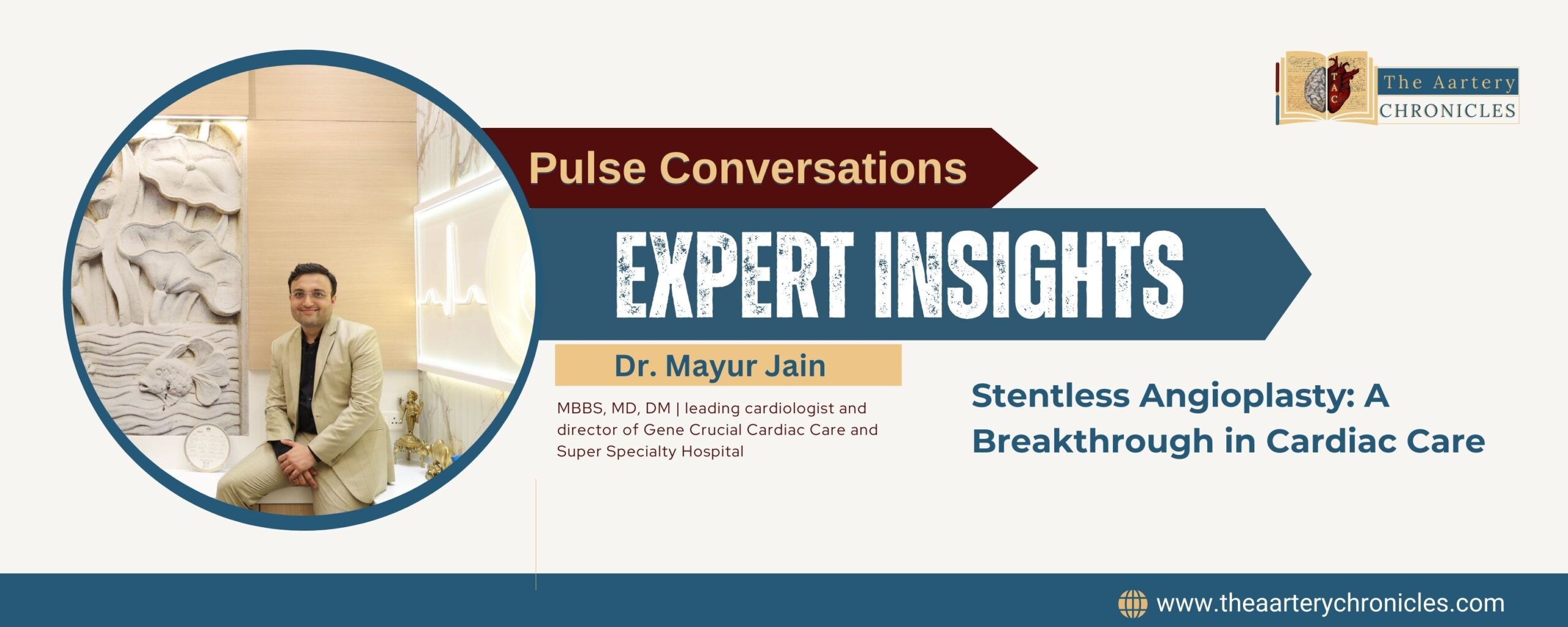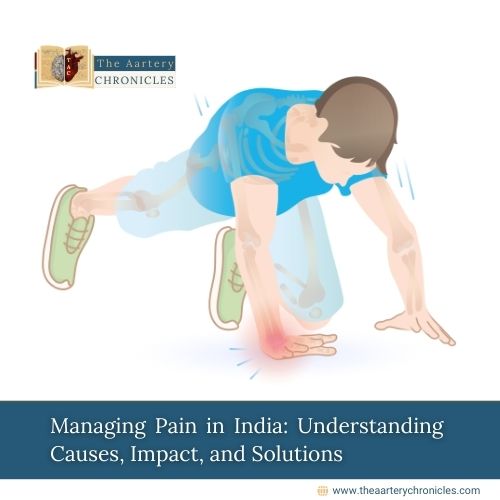

Stentless Angioplasty: A Breakthrough in Cardiac Care – Expert Insights by Dr. Mayur Jain
Overview
Cardiologists are always looking for ways to improve the treatment of heart disease, particularly when it comes to coronary artery blockages. One such innovation is stentless angioplasty, which provides a more minimally invasive alternative to traditional angioplasty with stent placement.
In a conversation with The Aartery Chronicles (TAC), Dr Mayur Jain, a leading cardiologist and director of Gene Crucial Cardiac Care and Super Speciality Hospital, simplified the innovative technique of stentless angioplasty and its numerous benefits.
With over 14 years of experience in cardiology, Dr. Jain brings a wealth of knowledge to the field. He completed his MBBS, MD, and DM at JJ Hospital and Grant Medical College in Mumbai. He further honed his expertise by training in structural heart disease and complex angioplasty at Fluid Clinic in Ohio, USA. Over the years, Dr. Jain has also undergone multiple training sessions in Transcatheter Aortic Valve Implantation (TAVI).
Having been practising cardiology for over a decade, Dr Jain is an expert in the field and hopes to shed light on the latest advancements in cardiac care. He hopes his insights will provide clarity on the evolving landscape of heart disease treatment, helping both patients and medical professionals stay informed about the most effective and cutting-edge techniques available today.
What is Stentless Angioplasty?
Dr Mayur Jain explains that stentless angioplasty, as the name suggests, refers to a procedure aimed at clearing blockages in the coronary arteries without the use of metal stents. Traditional angioplasty involves inserting a stent to hold open blocked arteries, which may remain inside the body permanently. In contrast, stentless angioplasty uses a drug-coated balloon to deliver treatment without leaving a foreign object behind.
How is Stentless Angioplasty Performed?
Dr Mayur Jain explains that stentless angioplasty is a minimally invasive procedure, typically done through a very small hole—around 3 to 4 mm—in the skin.
Step 1:
This technique is performed after an angiography, which is a diagnostic procedure used to identify blockages in the coronary arteries. The angiography is performed by inserting a small catheter through either the radial artery in the wrist or the femoral artery in the groin.
Step 2:
A catheter is inserted into the artery and guided up to the heart, specifically to the coronary arteries, which supply blood to the heart. Once the catheter is in place, a contrast dye, such as Omnipaque or Vizipaque, is injected into the arteries. This dye helps to highlight the blood vessels, allowing for clearer imaging.
Step 3:
The next step involves using a special machine called a catheterization laboratory (CATLAB). This machine captures a series of X-ray images, essentially creating a video of the blood flow through the arteries. These detailed X-ray images help the medical team assess the extent of the blockage and determine the most appropriate treatment, such as angioplasty, to restore proper blood flow to the heart.
Step 4:
Once the blockage is identified, a slightly larger tube, called a guide catheter, is inserted into the artery. This guide catheter is used to navigate through the blockage.
Step 5:
Next, a guiding wire is first passed through the blockage to create a pathway. Then, a balloon catheter is advanced over the wire. The balloon is inflated to open the artery, clearing the blockage. In the case of stentless angioplasty, instead of a metal stent, a drug-coated balloon is used. This balloon delivers medication directly to the artery wall, thus preventing re-narrowing of the arterial wall.
What is a drug-coated balloon and how does it work?
Dr Mayur Jain explains that the key innovation of stentless angioplasty lies in the use of drug-coated balloons. Instead of using a traditional metal stent, which stays in the body permanently, this technique allows the same drugs—like sirolimus or paclitaxel—that are typically found on stents to be applied directly to a balloon. The balloon is then used to deliver these drugs to the inner layer of the artery, known as the intima.
This approach eliminates the need for a metal stent, which, while effective, is a foreign object that remains inside the body. In contrast, the drug-coated balloon allows for the delivery of medication to treat the blockage without leaving a permanent metal structure. The balloon, coated with the drug (often using urea or other compounds to bind the medication), is inflated at the site of the blockage, helping to clear the obstruction and improve blood flow in the coronary arteries. This enhanced blood flow is crucial for the heart’s health, and angioplasty is designed to ensure that the heart receives the oxygen and nutrients it needs to function optimally.
Efficacy and Long-Term Benefits of Stentless Angioplasty
Dr. Jain explains that multiple studies spanning 5 to 8 years have shown that the long-term outcomes of drug-coated balloons are comparable to, and sometimes even better than, traditional stents. Key findings include:
- Reduced Target Lesion Revascularization (TLR): Dr. Mayur Jain explains that the efficacy of drug-coated balloons is often measured using Target Lesion Revascularization (TLR), a metric that tracks whether the same blockage requires further treatment after an initial angioplasty. Drug-coated balloons have been found to outperform stents, offering better long-term outcomes by preventing the reoccurrence of blockages.
- Benefits in Diabetic Patients and Non-Complex Lesions: Dr. Jain notes that drug-coated balloons are more effective in diabetic patients and in non-complex or moderately calcified lesions. Five-year follow-up studies show lower TLR rates with drug-coated balloons compared to stents.
- Lumen Expansion: Unlike stents, which are fixed in size, drug-coated balloons preserve the natural vessel structure, allowing for improved blood flow and even lumen expansion over time, a benefit not seen with stents.
- Acute Coronary Syndrome (ACS): Dr. Jain shares promising trial results showing that drug-coated balloons can be effectively used in acute coronary syndrome, particularly in cases like young patients or left main bifurcation, where complex stenting may not provide favorable long-term results.
Looking Ahead: Future Prospects
Dr. Jain is optimistic about the future of stentless angioplasty, especially as ongoing trials continue to provide more data. He anticipates further advancements that will enhance the use of drug-coated balloons in acute coronary syndrome and left main artery treatments, areas where initial trials have already shown excellent results.
Conclusion
In summary, stentless angioplasty with drug-coated balloons presents a promising alternative to traditional stenting, offering long-term benefits and reduced complications, particularly in specific patient groups. However, it is essential to carefully assess patient suitability, and as more data emerges, the use of this innovative technology is expected to expand, providing even more treatment options for heart patients.









